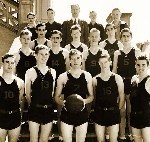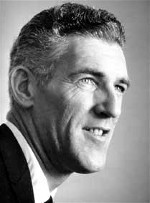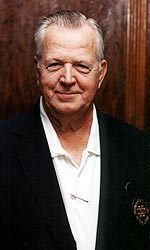July 5, 2005
By Pete LaFleur
The fourth entry in the Monogram Club’s “Tuesday Testimonial” series (see links to previous entries at the end of this release) pays tribute to recently-deceased Kevin O’Shea, the first four-year All-American in Notre Dame athletics history and still a basketball legend in his native San Francisco and among the Notre Dame faithful.
One year before his death in 2003, O’Shea attended the Notre Dame basketball program’s on-campus reunion. He was one of several former Irish players who sat down that day for a video interview, as part of the Monogram Club’s legacy project that provides an audio and video chronicle of the athletic department’s rich history. Excerpts of that interview with assistant SID/Monogram Club archivist Pete LaFleur are included below. It was one of the final interviews conducted by O’Shea, who passed away on Feb. 21, 2003.
When O’Shea headed to the Midwest to play for Notre Dame, he was labeled a “traitor” by the west-coast faithful in the San Francisco Bay area. Seven years later – with a stint in the coast guard filling the gaps – the west coast’s top prospect had become a legend on the northern Indiana campus as the program’s all-time leading scorer and the first four-year All-American in the history of Notre Dame athletics.
A native of the Luisetti area of San Francisco (named after the former Stanford basketball great Hank Luisetti), O’Shea was destined to play collegiately at a Catholic school, most likely nearby Santa Clara or St. Mary’s. His matriculation to a school thousands of miles away came a bit by chance (as detailed in his quotes below).
O’Shea was known during his Notre Dame career as a driven but calm competitor, with crafty dribbling skills and a deadly one-handed push shot that evoked memories of fellow Notre Dame All-American Leo Klier. The basketball teams during his four seasons combined for a 69-27 record while the football team never lost a game (36-0-2), winning three national titles during a truly golden age of Notre Dame athletics.
O’Shea earned the rare distinction of posting four All-America seasons when freshmen were granted eligibility for several years in the post-World War II era. He remains one of just 24 Notre Dame student-athletes ever to be a four-year All-American and is the only one to do so in basketball, with the others coming from the sports of fencing (15), cross country/track (4), women’s soccer (3) and baseball (1).

Kevin O’Shea fittingly was front and center in this photo of the St. Ignatius High School basketball team, which earned the No. 1 ranking in the state of California.
|
A graduate of San Francisco’s St. Ignatius High School, O’Shea went on to star as a crafty guard at Notre Dame from 1946-50 while playing for another Notre Dame legend in the imposing form of Moose Krause. O’Shea averaged 9.5 points per game as a freshman on the 1946-47 team that went 20-4 before earning consensus All-America honors as a sophomore (11.5 ppg). The player who became known as “The Comet” kept streaking in his final two seasons with more All-American honors, averaging 10.5 points as a junior (when he starred alongside future lifetime friend Leo Barnhorst) and 14.9 as a senior captain in 1949-50.
O’Shea’s 1,065 career points still rank 37th on the Notre Dame career scoring charts. He became the program’s first-ever 1st-round selection in the National Basketball Association draft, playing three professional seasons with the Minneapolis Lakers/Hawks and the Baltimore Bullets. He and four other Baltimore Bullets, including Bay Area legend Don Barksdale, played an entire game without a substitute, the first and only time that has happened in the NBA (and they won the game).
O’Shea – who currently is under consideration for the prestigious Bay Area Sports Hall of Fame – left the NBA in 1953 and co-founded an insurance company in San Francisco, running it until he retired in 1992. He engaged in a frustrating campaign to include early NBA players such as Barksdale and fellow San Franciscan Frank Kudelka in the league’s pension plan.
Former San Francisco Mayor John F. Shelley appointed O’Shea to the city’s Board of Permit Appeals in 1964 and to the Board of Supervisors in 1966. The playground basketball hero – who helped St. Igantius earn a No. 1 ranking in the state of California – also coached at camps sponsored by the San Francisco Examiner and run by fellow basketball legend Luisetti.

Kevin O’Shea sat down for a video interview at the 2002 Notre Dame basketball reunion, just one year before passing away in his native San Francisco.
|
Tuesday Testimonial – Entry #4, Kevin O’Shea (basketball, ’50); posted July 5, 2005 (quotes excerpted from a 2002 video interview; note that O’Shea passed away on Feb. 21, 2003)
“A neighborhood priest wanted me to go to Notre Dame. At first, he wanted me to go to St. Mary’s (in Moraga, Calif.) but he also had become a Holy Cross brother before he became a priest, so he had allegiance to Notre Dame. I told him I was going to go to Santa Clara, which was St. Mary’s arch-rival. He said to me, `How about Notre Dame?’ and I said it was too far away.
“I talked to my dad and – being as Irish as they come – he was very interested in Notre Dame and half-talked me into it. Part of the reason was the war came along in ’43. I had graduated from high school and was going to go to Notre Dame but Santa Clara abandoned athletics during the war.
“I came to Notre Dame in ’43. It was the first experience I had away from home and I was very interested and enlightened to see Notre Dame and the history it had. I met Moose Krause and Frank Leahy. The football team was practicing and Leahy had his eyes on me as a football player. Moose had to say, `Wait a minute, he’s a bask player.’ But Leahy still had me taking handoffs with Johnny Lujack and George Ratterman. I was always thinking he was going to make me play football but my knees were a problem and I never got on the football field.
“I was trying to get into the Naval V-7 program and was going to flunk out with an overbite. So I decided to go home and enlist in the Coast Guard and then came back after the war.
“We never lost a football game in four years I was here, although we did tie two games. If players today could realize what we had to do, because everybody wanted to beat Notre Dame. If they couldn’t beat us in football, then basketball had to be the next shot. Wherever we went, we were a target and we had to play harder than you’d ever believe.
“I grew up in the Lusetti are in San Francisco and we all learned to shoot one-handed. It was more unique to us out there. The jump shot eventually succeeded that. But I was a playmaker more than a shooter or scorer. If there was somebody that could shoot better than me, they would get the ball. I made sure of that. That was my job.
“We never had a losing season in those days [with records of 20-4, 17-7, 17-7 and 15-9] and were invited to the NCAAs every year, but in those days Notre Dame never accepted a postseason bid in football or basketball.
“Leo Barnhorst and I roomed together for two years and I got married after my sophomore year when my wife graduated from Cal Berkeley. She came back here and enjoyed Notre Dame as much as I did.
“Leo and I had great times and got to be great friends. I miss him very much. He was a very loyal Notre Dame man. I don’t think you could ever get a better one.

Leo Barnhorst – pictured here during the 1998 Monogram Club annual June meeting – formed a potent 1-2 punch with Kevin O’Shea as teammates on the Notre Dame basketball team in the late 1940s (Barnhorst was a longtime member of the Monogram Club board and attended 50 consecutive Monogram Club summer meetings, prior to his death in 2000).
|
“When you have your good nights, you remember them all. We beat NYU when they had won 19 straight and were No. 1 in the country, in Madison Square Garden. It was a great win and we had to stand up for Notre Dame, because they were really out to beat us badly.
“Kentucky was the perennial powerhouse. We played them down there the first year and got humiliated by 60-30 and you never forget losing one like that. So the following year when they came here, we gave it to them pretty good. They only lost one other game that year.
“We played out in the Cow Palace vs. St. Mary’s. It was a tremendous thrill and very nice of Notre Dame to do that because a lot of people back there don’t realize Notre Dame’s history and legend and feel we have for it. It was a nice opportunity to get back home.
“It was a great place to be. We had relationships that you couldn’t buy. The football team never lost a game when I was here and I still have relations with football players to this day. I was in regular contact with Johnny Lujack, Creighton Miller, George Connor. We all were so close, even though we were basketball players. There were others like George Ratterman, Frank Tripucka, Zeke O’Connor. Everyone had their own dorm. I don’t think I can comprehend how it is today, don’t think I could live on campus under the same circumstances they have today, although it is working well.
“Roy and Ray Pinelli were baseball players from San Francisco and were good friends of mine. Their father was a great umpire. One became a doctor and the other is a very successful businessman. They were good friends.
“When I went home from Notre Dame, there were only a few people from Notre Dame in the alumni association out there. And now we have a fantastic alumni association in the Bay Area, very enthusiastic and active out there. In those days, we had Buck Shaw at Santa Clara and Slip Madigan at St. Mary’s. There was Marchy Schawz and some other football coaches, other than that there weren’t not too many alums in the Bay Area.
“My father [Chris O’Shea] was a very successful bicyclist in Ireland. He won the Munster Finals Championship. He also was an all-Ireland hurler. I had a hurling stick when I was 10 years old. We used to cut down ash trees in Marin County to make our own sticks. Ash was very hard to get and my dad was a joiner and would make these stick for teams in San Francisco. I was athletic from a young age, on a bicycle before I could walk.
“I am capitalizing on all that Notre Dame is doing now and taking lot of credit I don’t deserve. If I was a student today, I probably could not get in here and we all think that way. The University has become the foremost Catholic university in the country and we are very proud of it. Maybe we deserve some of that credit and it’s nice to take some of that feeling on with us, and I hope it continues.
“People out there in San Francisco called me a traitor for not playing in the Bay Area. All the players I grew up with went to USF and USF won the national (NIT) title in 1950, so I possibly could have been there.
“Moose Krause was not noted to be the greatest coach in the world but he was a dedicated athlete, a great motivator and a great man. I used to play handball and father Tom Brennan was a great handball player and so was Moose. In the old Fieldhouse, they would take me over there and clean my clock in handball to let me know I had a lot to learn. Moose used to tell me what a good athlete I was. He thought I was a great golfer and I wish I could tell him that I’m down to a 12 handicap.
“Being a four-year All-American takes a combination of a lot of things. You have to be able to be a contender but also need a little push from the sports publicity people. Being Irish and being from Notre Dame didn’t hurt and we played a very good schedule.
“Leo Barnhorst always took a backseat because he was a workhorse and he was very helpful to me. Jack Neumayr was from San Francisco, St. Ignatius High School. He went to Yale and got a PhD and currently is president of Aquinas College. He was a very good high jumper, a very serious guy.
“Leroy Leslie was a fantastic shooter. Dan Bagley was the center from the Chicago area and a great player, he passed away recently. Don Strasser, also from Chicago, was a great ballhandler.
“John Loftus donated the Loftus Center, a wonderful guy. We roomed in the same hall, he lives in St. Charles, Illinois. Wayne Curran, his brother Fran was captain the year before. Our trainer was Huey Burns, quite a character. John Foley just passed away, our center. John Brennan also was a center and they shared time.
“It was a difficult team to pick because some got overlooked. One of reasons I came back after the war was Moose said, `When you come back, you’ve got the scholarship.’ Tom Foley was an assistant coach and never played a game for Notre Dame. They had given him a scholarship and never took it away from him.
“The Notre Dame Fieldhouse only held 4,800 people and when other teams came there they had a problem, because the student body was very vocal and seats were very close. You could run off the floor and end up in the stands. But it all worked to our advantage and we won 30-some games in a row at home before we lost in overtime to St. Louis.”
Tuesday Testimonial #1: Rosella Guerrero
Tuesday Testimonial #2: Brian & Rory Walsh
Tuesday Testimonial #3: Carrie Nixon
Do you have a recommendation of a former Notre Dame student-athlete to participate in the “Tuesday Testimonial” series? If so, please pass on the individual’s name and contact info. (if available) to Monogram Club archivist/publicist Pete LaFleur at lafleur.4@nd.edu.






